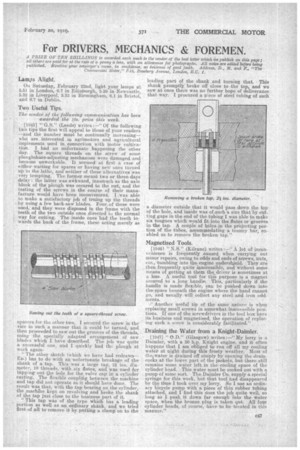For DRIVERS, MECHANICS & FOREMEN.
Page 21

If you've noticed an error in this article please click here to report it so we can fix it.
A PRIZE OF TEN SITILLINGS is awarded each week to the sender of the best letter which We publish on this page ; all Others are paid for at the rate of a penny a lane, with an allowance for photographs. All notes are edited before being published. Mention your employer's name, in confidence, as evidence of good faith. Address, IX, M. and F., "The Commercial Motor," 7115, Rosebery Avenue, London, E.C. 1.
Lamps Alight.
On Saturday, February 22nd, light your lamps at 5.51 in London,6.7 in Edinburgh, 5.39 in Newcastle, 5.52 in Liverpool, 5.53 in Birmingham, 6.1 in Bristol, and 6.7 in Dublin.
, Two Useful Tips.
The sender of the following communication has been awarded the 10s. prize this week. • • [1945] "0.8." (Leeds) writes :—" Of the following • , two tips the first will appeal to those of your readers —and the number must be continually increasing— who are interested in agrimotors and agricultural implements used in connection with motor cultivation. I had an unfortunate . happening the other . day. The square threads on the screw of sonic ploughshare-adjusting mechanism were damaged and •
• became unworkable. It seemed at first a case of either waiting for spares or having new ones turned up in the lathe, and neitherof these alternatives was very tempting. The former meant two or three days delay: the latter was awkward, inasmuch as the axle Mock of the plough was secured to the nut, and the testing of the screws in the course of their manufacture would have been inconvenient; I. was able to make a satisfactoty job of truing up the threads by using a few hack-saw blades. Four, of these were used, and they were disposed in. the frame with the teeth of the two outside ones directed ein the normal
• way for cutting. The inside Ones had the teeth towards the back of the frame, these acting merely as spacers For the other two. I secured the screw in the vice in such a manner that it could be turned, and then proceeded to saw out the grooves of the threads, using the specially adapted arrangement or saw blades which I have described. The job was quite a successful one, and I quickly had the plough at work again.
" The othersketch (which we have had redrawn— En.) has to do with an unfortunate breakage of the shank of a tap. This was a large tap, 2* iris. diameter, 10 threads, with six flutes, and was used for tappIng out the hole for the valve cap in a cylinder casting. The flexible coupling between the machine and tap did not operate as it should have done. The result was that, with the tap bearing on the cylinder, the machihe kept on revolving and broke the shank of the tap just close to the business part of it.
"This tap was of the type which has a leading portion as well as an ordinary shank, and we. tried first of all to remove it by patting a clamp' on to the
leading part of the shank and turning that. This shank promptly. broke off close to the top, and we saw at once there was no further hope of deliverance that way. I procured a p:ece of steel tubing of such a diameter outside that it would pass down the top . of the hole, and inside was of.Such-it size that laY cutting gaps in the end of the tubing I was able to make six tongues which would fit into the flutes or groo#es -in the tap. A couple of holes in the prOjecting portion of the 'tubes, accommodating a tommy bar, enabled us to remove the broken tap."
Magnetized Tools. .
[19461 "N.S." (Kilrane) writes :—" A lot of inconvenience is frequently caused, when carrying out minor repairs, owing to odds and ends of Screws, -nuts, etc., • tumbling into the engine undershield. They are then frequently quite inaccessible, and without some means of getting at them the„.driver is sometimes at a loss. A. useful tool for this purpose is a magnet secured to a long handle. This, particularly if the handle is made flexible, can be pushed down into the:space beneath the engine where the hand cannot go, and usually will collect any steel and iron oddments.
-" Another useful tip of the same nature is when replacing' small screws in somewhat inaccessible positions. If one of the screwdrivers in the tool box have its business end magnetised, the operation of replacing such a screw is considerably facilitated."
,Draining the Water 'from a Knight-Daimler.
L1947] " 0.D." (Glasgow) writes :—" My lorry is a Daimler, with a 30 h.p. Knight engine, and it often happens that I am obliged to run off all my cooling water at night during this frosty. Weather. Most of the.water is drained off simply jackets, opening the drain cocks at the lower part of the but there still remains some water left. in the cooling space of the cylinder head. This water must be sucked out with a pump of some sort. The Daimler Co. supply' a special syringe for this work, but that tool had disappeared by the time I took Over my lorry. Bo I use an ordinary bicycle pump with a piece of thin rubber tubing attached, and I find this does the job quite well, so long as I push it down far enough into the water space, when the bronze plug is taken qut. All four cylinder heads, of course, have to be treated in this manner."






















